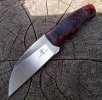I think most all the knife suppliers sell the 3M papers now. They are also popular in the jewelry industry for hand polishing platinum. Jewelry suppliers carry them.
Oh, I forgot to say, while they are simply called 3M polishing papers in the industry, the actual full brand name is
"3M wet-or-dry Tri-M-ite Polishing Paper". It comes in six color coded sheets from 400 to 8000 grit. Here is a link to a random supplier in a search for info only :
http://www.contenti.com/products/abrasives/210-044-01.html
General tips for sanding knife blades and handles using 3M papers:
Mark the back of each sheet with the grit equivalent when they are new ( just use a laundry marker or sharpie). This prevents using the wrong side and getting the grit order confused. The white 8000 sheet is very hard to tell front from back once used, so mark it's back right out of the wrapper.
Keep the sheets by color/grit in large plastic bags. Cut some up into 1/4s to use for small sanding jobs. They can be used again until completely worn out.
Sand to 800/1000 grit with SC paper or belts, clean everything really well, and go back to the green/400 3M sheet and go up the grits when getting a final finish.
Even if you plan on stopping with a satin finish on a blade or handle, go past that and do at least two papers finer. This will quickly expose small scratches you missed. Once you've got them all sanded away, go back down the grits to the finish desired.
Wet sanding leaves a much smoother and crisper finish than dry. Wet sanding wood is not usually a good idea. However, plastics and steel both do well with wet sanding. Plastic should be done with water only. When using water on blades, a few drops of dish soap added helps a lot. Water is really a good agent for sanding and is easy on the hands and such, but isn't a great idea on blades already mounted if it might seep under the handle. On knives where water would be a problem, oils can be used as the lubricant.
Water or oil, use just enough to "wet" the blade surface and carry the grit and swarf. Wipe/wash off frequently and don't let dry up in sanding.
Wash everything
thoroughly between grit changes....especially your hands. Change the water tub and rinse it out, change the wiping towels or cloths, wipe off the sanding jig, etc.. Coarser grits can hang around a long time and suddenly jump out at 8000 to make you curse.
Japanese blades tip:
If you do hybrid togi, cut the papers into approximate 1" squares and put in marked plastic bags. Use a piece to polish a small area and then toss it. I sometimes use a small square of leather as a backer between my thumb/finger and the polishing paper. The 3M papers will take a blade to a really bright finish. A final polish with your slurry of choice and a stack of gun cleaning pads will make it a mirror. The small cut up pieces of polishing paper are super good for working around the hamon in the final shiage togi. Little triangular wedges of leather, used as a backer, will get right up to delicate details without risk. This works pretty much like using hazuya and jizuya stones...but much easier and neater. A single $1.25 sheet of polish paper makes a bag of 100 squares.

